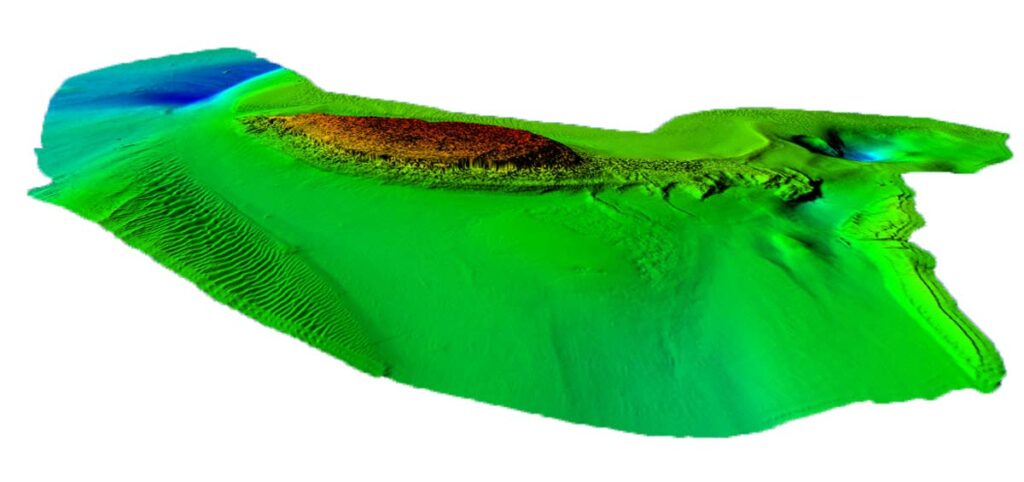News Letter
Location Map
Introduction
Welsh project area 3 encompasses a hugely diverse range of natural environments and heritage sites which are vulnerable to the impacts of climate change which include erosion and sea-level rise. The archaeological and palaeoenvironmental investigations undertaken by CHERISH within this area include coring of lakes to reconstruct millennial-scale environmental change, dating of sand movement events, seabed scanning, intertidal wreck surveying, and the excavation of an eroding prehistoric coastal fort. Archaeological evidence demonstrates that people have roamed and occupied this stretch of coastline for thousands of years. However, CHERISH is uncovering the dynamism of the coastal environment that has shaped not only the coastline but the lives of its inhabitants through combined palaeoenvironmental and archaeological investigations.
Rhosneigr

Rhosneigr is a small village occupying a bedrock outcrop on the southwest coast of Anglesey. Below the village is a 20 hectare lake known as Llyn Maelog which is separated from the beach by a 500m-wide sand-dune complex. The dunes rise to a height of about 20 metres immediately behind the beach Traeth Llydan. The lake is a significant ecological habitat for a range of plants, birds and animals, but is also an important focal point for residents and tourists alike. It is surrounded by a diverse range of important archaeological sites such as burial tombs, settlement sites, and the site where 180 iron and copper alloy objects were discovered. Therefore, it seems likely that this substantial freshwater lake would have been a significant site in the past.
Llyn Coron
Llyn Coron is a 30-hectare lake impounded by the Aberffraw dune system, about 5 km southwest of Llyn Maelog. The lake was thought to have developed in the medieval period, which documentary evidence suggests was a particularly stormy period in the region. It is believed that as the sand dunes developed, they blocked the River Ffraw creating a natural dam and the lake formed behind them. The dune system covers about 360 hectares and together with the lake forms part of a Special Area of Conservation and Site of Special Scientific Interest.

CHERISH is investigating the lake sediments to see if they contain a record of storminess that can be used to identify changes in past weather patterns. We are using chemical elements such as bromine and the physical presence of sand grains to reconstruct changes in storm intensity or frequency. We are combining these techniques with OSL dating to date layers of sand and provide a chronology for the core. We are also looking at how different species of diatom (microscopic algae found in all waterbodies) responded to the lakes evolution. Diatoms are sensitive to light, pH, salinity and the nutrient status of their environment, which makes them good indicators of
Dinas Dinlle & Morfa Dinlle

Situated at south-western entry to the Menai Strait is Morfa Dinlle which is the largest active gravel beach ridge system in Britain. It comprises a series of linear ridges (some over a kilometre in length), which have accumulated in a north-westerly direction. The central section also contains a large sand-dune complex which combine with the gravel ridges to form an important and fragile coastal ecosystem supporting many rare fauna and flora. Previous research suggests that the ridge system has developed over the last 2000 years, but the exact rate of the spit growth has not been established. It is also unclear how future sea-level rise may affect its development. CHERISH is aiming to provide a detailed chronology for the evolution of the spit to better understand the formation process and coastal sediment transport.
About 3 km to the south of Morfa Dinlle is the heavily eroded prehistoric coastal fort of Dinas Dinlle. The site is situated upon a glacial moraine, which has been sculpted and modified by people in the distant past to create a formidable series of defences. The western elevation is being actively eroded by climatic and coastal processes, resulting in the loss of the western rampart which likely completely enclosed the settlement in the past. Geophysical surveys and excavations of Dinas Dinlle by CHERISH have uncovered evidence of a substantial settlement site within the fortifications, most notably the discovery of a stone-built roundhouse which is 13 metres in diameter – the largest of its type known in Wales. Archaeological finds indicate occupation during the Romano-British period but it is likely that it was constructed during the Iron Age period. Whilst the structures themselves are extremely impressive and important, the fact that they are entombed in vast quantities of wind-blown sand is perhaps more intriguing. Although we cannot be certain, it is possible that the fort was eventually abandoned due to sand inundating the site. The scale of sand deposition emphasises the power and hazards associated with the natural coastal environment and its ability to impact the communities that occupy and utilise the coastal zone.

CHERISH is using Optical Stimulated Luminescence (OSL) dating on the sand deposits that overlay the roundhouse, together with samples from the eroding cliff face and the dunes at Morfa Dinlle to determine when these sand deposits were laid down. We hope this technique will provide a robust chronology for the sites themselves, but we are also trying to reconstruct a regional picture of coastal environmental changes investigating other sites in the area. CHERISH also hopes to provide a palaeoenvironmental context for human occupation of the fort.
Why are we working here?





















